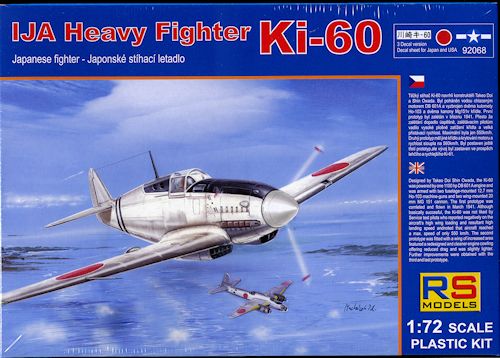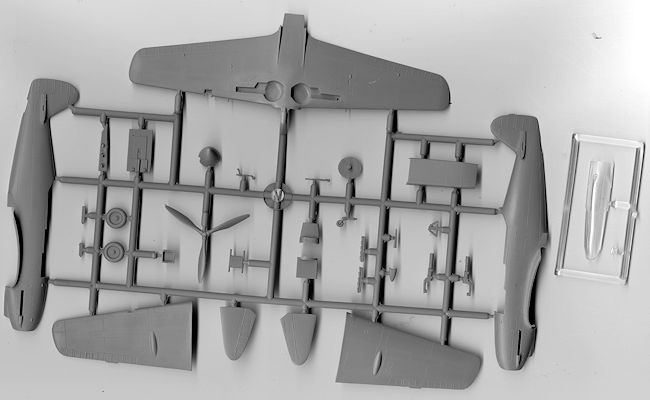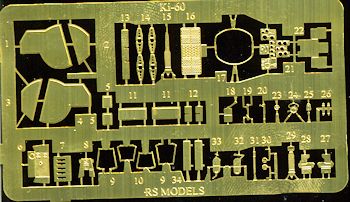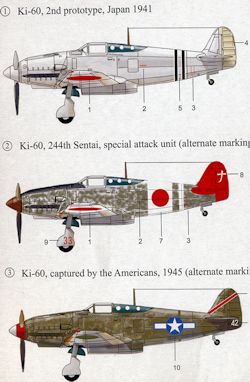
| KIT #: | 92068 |
| PRICE: | $27.95 SRP |
| DECALS: | Three options |
| REVIEWER: | Scott Van Aken |
| NOTES: | Short run with photo etch parts. |

| HISTORY |
The Ki-60 was designed by Takeo Doi and his deputy Shin Owada of Kawasaki Aircraft Industries (川崎航空機工業株式会社 Kawasaki Kōkūki Kōgyō K.K.) in response to a 1939 Imperial Japanese Army Aviation Bureau requirement for a heavily armed specialised interceptor fighter to be powered by the liquid-cooled Daimler-Benz DB 601 inverted V12 engine, which had been selected for license production by Kawasaki as the Ha-40. The emphasis in the requirements was for a high speed and a good rate of climb, along with a cannon armament. This was a complete change from the usual IJAAF penchant for lightly armed, highly manoeuvrable fighters with lightweight structures, epitomised by the Nakajima Ki-27 and the later Nakajima Ki-43. A requirement was issued at the same time for a lighter, less heavily armed, general-purpose fighter which was to be designed almost in parallel with the Ki-60; this became the Ki-61. Priority was to be given to the Ki-60, design of which started in February 1940.
The first prototype of the Ki-60 emerged in March 1941 as a compact, all metal, stressed skin monoplane with a relatively deep fuselage (1.46 metres or 4 feet 9 inches) and tapered wings with rounded tips built around a system of three spars; a Warren truss main spar and two auxiliary spars. The rear spar carried the split flaps and long, narrow chord ailerons, while the front spar incorporated the undercarriage pivot points. The undercarriage track was 3 metres (9 ft 10 in). The pilot's seat was mounted high over the rear spar, giving the fuselage a distinctive "humped" profile; the hood featured a framed, rear sliding canopy and an elongated rear transparent section. The main coolant radiator was housed in a long ventral bath under the wing centre-section and central fuselage, while the oil cooler was mounted under the engine with a long air intake. The prototype was powered by an imported DB 601A as production of the Ha-40 had not yet started. A total fuel capacity of 410 l (90.2 Imp gallons)) was carried.
The armament carried was two synchronized, fuselage mounted 12.7 mm caliber Ho-103 machine guns which were set in a "staggered" configuration (the port weapon slightly further forward than that to starboard) in a bay just above and behind the engine. One German made Mauser MG 151/20 20 mm cannon was housed in a weapons bay in each wing. With a normal loaded weight of 2,890 kilograms (6,400 lb) and a gross wing area of 15.9 square feet (1.48 m2) the wing loading was 181.76 kg/m² (37.23 lb/ft²), which was extremely high by Japanese standards (the standard IJAAF fighter, the Ki-27, had a wing loading of 70 kg/m² (14.33 lb/ft²).
From the start of flight testing it became apparent that the design was seriously flawed in several key areas. The take-off run was unacceptably long, while in flight the aircraft displayed some lateral instability, excessively heavy controls and poor control response. The spinning characteristics were described as "dangerous" and the stalling speed was extremely high. Although a top speed of 600 kilometres per hour (370 mph) had been projected the Ki-60 was only able to achieve 548 kilometres per hour (341 mph).
As a result the second and third prototypes, which were still being built, were hurriedly modified in an attempt to mitigate some of the more undesirable traits. Some 100 kilograms (220 lb) was removed, primarily by replacing the MG 151 cannon with Ho-103 machine guns, reducing the normal loaded weight to 2,750 kilograms (6,100 lb). Coupled with a slight increase in wing area to 16.20 square feet (1.505 m2) this resulted in a slightly lower wing loading of 169.7 kg/m² (34.76 lb/ft²). Detail changes were made to airframe sealing and to the contours of the air intakes and radiator bath. Flight tests were still disappointing, with both of the modified prototypes displaying most of the shortcomings of the first. A top speed of only 560 kilometres per hour (350 mph) was reached, with a climb rate still well below specifications. By this time the Nakajima Ki-44, which had also been designed as a dedicated interceptor, was beginning to show some promise and the Koku Hombu selected this in fulfillment of its requirements. From early 1941 the full attention of Takeo Doi and Shin Owada was focused on the Ki-61; the Ki-60 became important in that the Ki-61 design was able to be improved using the lessons learned from the poor characteristics of the Ki-60.
| THE KIT |
 For many
years, one of my modeling 'themes' in 1/72 has been Japanese Army fighters; the
Ki- planes (pronounced key). So when a certain major mail order place had a sale
of RS Models kits, where there were quite a few Japanese experimental types
offered, I went ahead and picked up a few.
For many
years, one of my modeling 'themes' in 1/72 has been Japanese Army fighters; the
Ki- planes (pronounced key). So when a certain major mail order place had a sale
of RS Models kits, where there were quite a few Japanese experimental types
offered, I went ahead and picked up a few.
Typical of RS kits, this one is on a single grey sprue
with a one-piece injected canopy and a fret of photo etch. The molding on the
kit parts is quite good with nicely done engraved detailing. All of the large
parts have pretty good sized ejector stubs on them that will need to be removed
prior to construction. I was pleased that the kit has a one-piece prop as I am
not all that fond of separate prop blades. The wheels are also a single casting.

Pretty much all of the cockpit aside from the floor,
seat and control stick is in photo etch. The photo etch is well done and the
brass is rather thin. As you can quickly see, the main gear doors and tail gear
 doors are in
photo etch as are the gear oleo scissors. RS has also provided the rudder,
elevator and aileron actuating rods on this sheet, but most of it is for the
cockpit.
doors are in
photo etch as are the gear oleo scissors. RS has also provided the rudder,
elevator and aileron actuating rods on this sheet, but most of it is for the
cockpit.
Instructions are a single folded sheet and provides no
interior or wheel well color information. You pretty much have to glean that
from what little is shown on the painting and decal guide on the back of the
box. Or take a guess. For instance, the aft transparency brace is listed as
Aotake. However, we know that the Ki-61 cockpit was more of a desert tan in
color, so you have a choice here. Construction drawings are well done and show
where all the bits are supposed to go. Since the Ki-60 was built in protot ype
form only, there are two 'whiffer' decal options. One is a captured version and
the other allegedly with the 244 Sentai, but without their distinctive tail
marking. The decals are well printed and are sure to be quite thin. The US
insignia has the overly elongated bars that we have seen before on captured
Japanese planes.
ype
form only, there are two 'whiffer' decal options. One is a captured version and
the other allegedly with the 244 Sentai, but without their distinctive tail
marking. The decals are well printed and are sure to be quite thin. The US
insignia has the overly elongated bars that we have seen before on captured
Japanese planes.
| CONCLUSIONS |
Anyone who is building a collection of Japanese aircraft and wants to include prototypes will really want to seek out this kit. I am sure it has been done before in resin or older short run, but this one looks like it is quite a bit nicer than most older kits. The 'whiffer' crowd and those who like to do Japan '46 stuff will also find it to be of interest.
| REFERENCES |
http://en.wikipedia.org/wiki/Kawasaki_Ki-60
June 2013
Thanks to me for picking this one up.
If you would like your product reviewed fairly and fairly quickly, please contact the editor or see other details in the Note to Contributors.